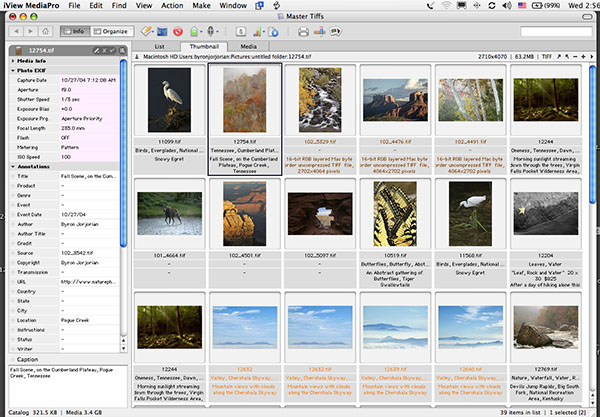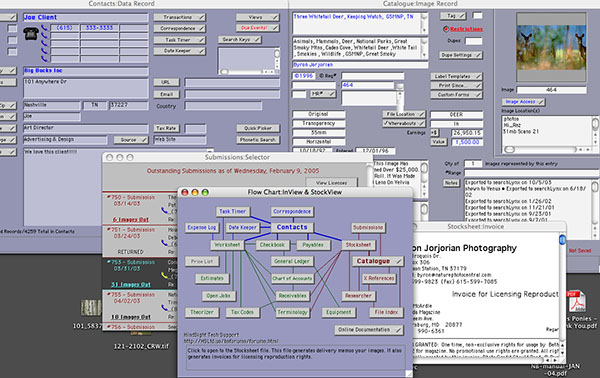Getting things off the ground you will find
is the toughest part of selling your images as stock. Once things
get moving and your system is in place, it will get easier all
the time. In fact, what you want to get to, is a place where
locating and contacting clients and then submitting images is
almost automatic. An assembly line operation, if you will.
Researching the Market continued
In our last installment, we discussed how to find potential clients.
Here are some other ideas for locating clients.
Almost every area of interest, every hobby, from fishing and
knitting to model railroads, has a number of publications,
websites, trade magazines, books and catalogs devoted to it.
These are all potential clients. Obviously, the special interests
that command larger audiences also have a higher demand for
images and they will pay more for them.
Consider telling your friends and relatives about your ventures.
They may know art directors or editors in companies that need
the type of images that you produce. Experts say that everyone
knows at least 200 people. Those 200 people also know 200 people.
That means by contacting the 200 people you know and asking for
referrals, you have gained access to more than 40,000 potential
photo buyers!! Naturally, they aren’t all clients but you
only need a few for your business to begin moving forward.
This was one of our first promotional pieces. I simply took
a number of publications that had used my work and arranged them
on the ground to fill the frame and took a picture of them on
slide film. At various times I have used this as a stand alone
handout piece, a web site image and a mailer that went into an
envelope with our query letter.

Making Contact
There are many more ways to break into the market than we have
room to discuss here. So, let’s take a close look at
one method that most anyone can pursue.
First, we need to get a copy of the publications submission
guidelines, beginning with the list of names we developed from
our research in Part 1 of this series.
1. Choose the name of the client you feel may have an interest
in the kind of photography that you do.
2. On professional looking stationery, compose a query letter
to the photo buyer that goes something like this:
Dear Photo Buyer,
I am a Tennessee based photographer specializing in wildlife,
nature, and scenic photography.
My work has appeared in hundreds of publications around the world. I am interested
in submitting work for your consideration. Please send me a copy of your submission
guidelines, a SASE is enclosed for your convenience. I have also enclosed a
promotional packet so that you may learn a little about me in the meantime.
Best regards,
Joe Photographer
3. Be sure to include a short biography if you have one and
most important a SASE (Self addressed stamped envelope). Most
buyers won’t respond without one.
When you get those submission guidelines back, then you are
ready to get down to business! (The guidelines that you receive
from them will outline the steps to submitting images and any
special needs they may have. Often they will also tell you how
much they pay).
While you have been sending out your letters and waiting for
the submission guidelines to get back to you in the mail. It
is important to begin getting ready to have a smooth running
business.
Getting Organized
Back at the office it is critical that images be located and
sent out quickly. If you can’t find an image you can’t
sell it. I have found that often times getting an image request
filled quickly will result in more sales.
Here are a few of the essentials:
I have been 100% digital for about 3 years now but I still have
more than 100,000 slides that are still very marketable.
For slides and transparencies:
1. I use archival slide pages with plastic spines in hanging
metal file cabinets. The metal files cabinets are organized
with hanging file drawers, divided by subject. These subjects
are arranged alphabetically. Example: Abstracts, Amphibians........
The subjects are divided with
hanging file dividers that have the name of the subject written
on the tab. As the subject grows, breakdown the subject into
smaller subcategories, such as in Birds....cardinals, eagles,
herons, etc., or in Mammals.....bears, deer, raccoons, etc.
Important transparencies and any images that are going to be
sent to a
client are placed in the 2x2 individual transparency sleeves before they are
put into the 20 pocket slide pages. This will provide your image with that
extra measure of protection when they are handled by a client
with “sticky donut fingers”.
2. The digital files are stored on external hard drives and backed
up on the Gold, 300 year archival cd’s, such as eFilm
brand. I use Iview MediaPro to quickly organize my raw files,
scans and processed Tiff files.

Screen shot from IView Media Pro
3. The scans and Tiffs are tracked for submission, rights management
,billing, income recording, etc., with Inview & Stockview
by Hindsight. This product, in my opinion, is the essential stock
photography business management software.

Screen shot from InView and StockView showing the flow chart
of all available fields and a few of the data entry fields that
are commonly used
4. As far as numbering images, there are many systems, but I
have found that with nearly 150,000 images under management that
the simpler the numbering system that you use the more likely
that you will stick with it. Most important is to make sure that
whatever numbering system you use that you won’t end up
giving two different images the same number. I came up with a
very unique system I found that numbering the images 1, 2, 3,
4 .................10827, 10828, etc, etc gives you an unlimited
number of possible images, avoids confusion and duplication.
In our next installement we will take a look at actually preparing
a digital and film submission to the photobuyer. We will
also cover some of the basics of rights management and negotiating
prices.
For more information on Byron's, " Marketing Your Images" 2-Day
retreat, go to
www.naturephotocentral.com
|